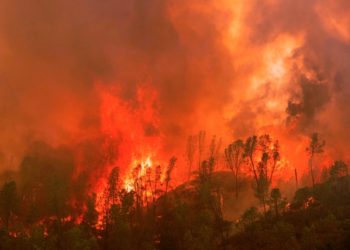 The massive fires raging in California are being blamed squarely on climate change. Alongside ominous photographs of orange skies, the front page of the Sunday Los Angeles Times blared: “California’s Climate Apocalypse.”
The massive fires raging in California are being blamed squarely on climate change. Alongside ominous photographs of orange skies, the front page of the Sunday Los Angeles Times blared: “California’s Climate Apocalypse.”
Golden State Gov. Gavin Newsom says the cause is climate change. Anyone who thinks differently, he insists, is in denial. …
But the claim that the fires are caused by climate change is grossly misleading. Translated into policy, it would steer the state to the worst way to help future Californians.
To understand why it helps to know that California wildfires used to be much bigger. This past decade, California has seen an average burnt area of 775,000 acres. Before 1800, however, California typically saw between 4.4 and 11.9 million acres burn every year.
In other words, up to 12 percent of the entire area of the state — had its modern boundaries existed in the 18th century — burned every year. Old newspapers across the country were filled with descriptions of terrible fires.
Back then, “skies were likely smoky much of the summer and fall in California,” as one academic paper noted. Elsewhere in the country in 1781, “the smoke was so dense that many persons thought the day of judgment had come,” The New York Times reported a century later.
This all changed after 1900 when fire suppression became the norm, and fires declined precipitously. In the last half of the 20th century, only about 250,000 acres burned annually.
But because most fires were stopped early, this left ever more unburnt fuel in the forests. According to one estimate, there is now five times more wood-fuel debris in Californian forests than before Europeans arrived.
Clearly, then, we used to have much more fire before global warming. Even this year’s record-breaking 2.3 million burnt acres is about half the lower end of a typical year in earlier times.
And the main reason we are now seeing more and bigger fires is that our century of fire suppression has left what researchers call a “fire deficit” — all the fuel that should have burnt but didn’t. It is now waiting to burn even hotter and fiercer.
Newsom is right that climate plays a part. It does create a more favorable fire environment by increasing hot and dry conditions. But experts estimate this plays a minor role. The much more important factor is the way we manage forest lands and develop our landscape.
When we keep suppressing fire, we ask for bigger and more terrible future fires. And we know how to fix this. We simply have to make many more prescribed burns that eliminate the built-up fuel.
This is doable and smart. It would help reduce fire risks in just a few years. Unfortunately, it is also unpopular, because of increased smoke and risks from uncontrolled fires.
One prominent study published in Nature Sustainability this year estimated that California will have to burn about 20 percent of its area to get rid of all the excess fuel. But owing to popular opposition, legal challenges, and regulatory limits, California manages prescribed burns for less than one-thousandth of that.
Instead of focusing on more prescribed burns, Newsom focuses on climate change as the overarching source of his state’s fires. He suggests that the answer is to speed up California’s transition to 100 percent renewable energy sources.
But any realistic climate solution will achieve next to nothing. A Californian change of policy will have virtually no impact on global climates.
But even if the entire United States were to cut all its emissions tomorrow and for the rest of the century — an incredibly fanciful and enormously expensive assumption — temperatures would still climb, just 0.3°F less.
Fires would still get worse, only slightly less.
Californian fires are slowly coming back to their prehistoric state because of the enormous excess fuel load. Putting up solar panels and using biofuels will be costly but do virtually nothing to fix this problem. Prescribed burns will. What we choose depends on the information we get.
Bjorn Lomborg is president of the Copenhagen Consensus and a visiting fellow at the Hoover Institution, Stanford University. His new book is “False Alarm: How Climate Change Panic Costs Us Trillions, Hurts the Poor, and Fails to Fix the Planet.”
Read more at NY Post

















A fully ignored side effect of the fires this year is that the large scale use of PV solar has been seriously impacted by the thick smoky haze blanketing much of the state and neighboring states. The smoke has diminished sunshine such that it feels like we’re living in an old style sepia photograph. It has been like living with a heavy veil over the sky for nearly three weeks at this point, praying for the veil to be lifted.
The dimmed sunshine is manifesting itself in severely reduced PV efficiency, many rooftop installations are generating at low single digit percentage of capacity. Makes one wonder what the kWh deficit is for the giant PV farms…
AN UNANSWERED QUESTION IS WHY CLIMATE CHANGE ATTACKED ONLY GOVERNMENT MANAGED FORESTS (60% OF FORESTS IN CALIFORNIA) AND LEFT PRIVATE FORESTS (40% OF FORESTS IN CALIFORNIA) ALONE.
https://tambonthongchai.com/2020/09/15/privately-owned-forests-in-california/
Very useful information – thank you…..